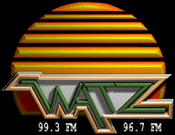WATZ-FM
WATZ-FM (99.3 FM) and WRGZ (96.7 FM, "WATZ 99.3 and 96.7") are two radio stations simulcasting a country music format. The two stations are licensed to the cities of Alpena (WATZ) and Rogers City, Michigan (WRGZ). WRGZ first began broadcasting in 1984 under the call sign WMLQ while WATZ has been assigned the same call sign since it signed on in the late 1960s. The stations, along with sister station WATZ AM, are currently owned by Midwestern Broadcasting Company.
 | |
| City | WATZ-FM: Alpena, Michigan WRGZ: Rogers City, Michigan |
|---|---|
| Broadcast area | WATZ-FM: WRGZ: |
| Frequency | WATZ-FM: 99.3 MHz WRGZ: 96.7 MHz |
| Branding | WATZ |
| Slogan | Today's Country |
| Programming | |
| Format | Country |
| Affiliations | Michigan Radio Network |
| Ownership | |
| Owner | Midwestern Broadcasting Company (WATZ Radio, Inc.) |
| Sister stations | WBCM, WCCW, WCCW-FM, WJZQ, WTCM, WTCM-FM, WZTK |
| History | |
| First air date | WATZ-FM: unknown WRGZ: 1983 |
| Former call signs | WATZ-FM: none WRGZ: WVXA (4/1/88-5/30/06) WMLQ (3/5/84-4/1/88) WNSR (1/9/84-3/5/84) WOEA (7/19/83-1/9/84) |
| Former frequencies | WATZ-FM: 93.5 MHz (?-4/1/88) WRGZ: 97.7 MHz (3/5/84-?) |
| Call sign meaning | WRGZ: RoGerZ City |
| Technical information | |
| Facility ID | WATZ-FM: 71108 WRGZ: 49304 |
| Class | WATZ-FM: C2 WRGZ: C2 |
| ERP | WATZ-FM: 17,000 watts WRGZ: 42,000 watts |
| HAAT | WATZ-FM: 257 meters WRGZ: 162 meters |
| Links | |
| Website | watz.com |
WATZ history
WATZ signed-on the air in the late 1960s, as an adult contemporary station at 93.5 FM, known for several years as "Z93." In 1988, the format of WATZ-FM was changed to country and the frequency-signal moved to 99.3 so that the station could boost its power from 3,000 to 50,000 watts. For the next several years, WATZ-FM simulcasted the long-time country music format of sister station WATZ AM. In the mid-90s, WATZ AM had switched to a news/talk format while WATZ-FM retained the country format. WATZ-FM became a 24-hour broadcaster in 1999, using a satellite feed from Jones Radio Networks from 11 p.m. to 5:30 a.m. Prior to this, the station went off the air at 1 a.m.
WRGZ history
WRGZ began as the 26,000 watt WMLQ, "Mello-Q", an adult contemporary station at 97.7 FM, in 1984. The station went through numerous changes during the 1990s, including a move to the current 96.7 frequency and a long-running adult standards format as "Silver 97." In 1998, the station was purchased by Xavier University in Cincinnati and converted into a public radio station. It became a "repeater" of WVXU, the public radio station operated by the university, and its call letters were changed to WVXA. WVXA also featured a small amount of local programming in addition to the WVXU simulcast.
In August 2005, WVXA was sold to Cincinnati Public Radio, although it continued to serve as a "repeater" of WVXU. At the same time, the station's power was increased to 42,000 watts. Cincinnati Public Radio was not interested in retaining ownership of WVXU's "repeater" stations outside Ohio and sold the station to Midwestern in March 2006. After the sale was closed the following May, its call letters were changed to WRGZ and it began repeating WATZ. WRGZ allows WATZ's programming to be heard in areas where the 99.3 FM signal is not heard clearly, as far north as Cheboygan and into the eastern Upper Peninsula.
WATZ today
WATZ-FM remains locally owned and operated by the same company that founded the AM station in 1946. All of its programming from 5:30 a.m. to 11 p.m. on weekdays, and during the day on weekends (except for syndicated shows such as Bob Kingsley's Country Top 40) is broadcast from the station’s studios in downtown Alpena.
External links
- Official website
- WATZ in the FCC's FM station database
- WATZ on Radio-Locator
- WATZ in Nielsen Audio's FM station database
- WRGZ in the FCC's FM station database
- WRGZ on Radio-Locator
- WRGZ in Nielsen Audio's FM station database